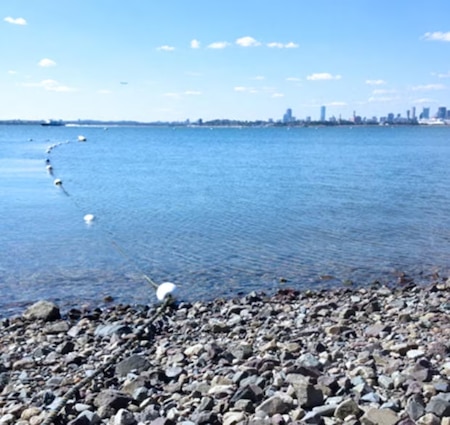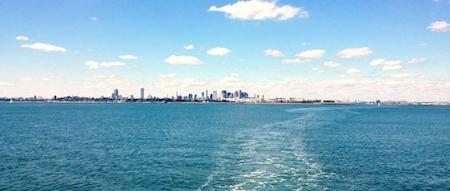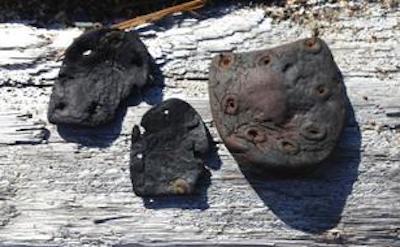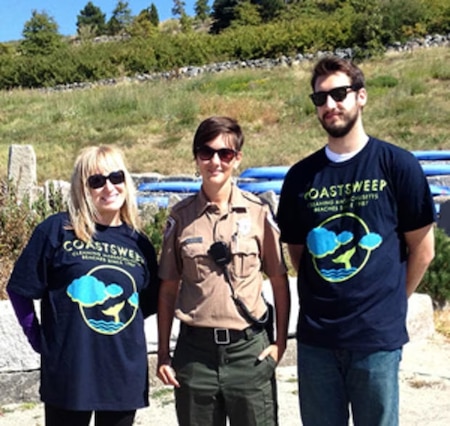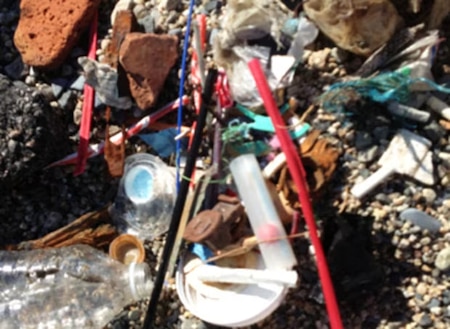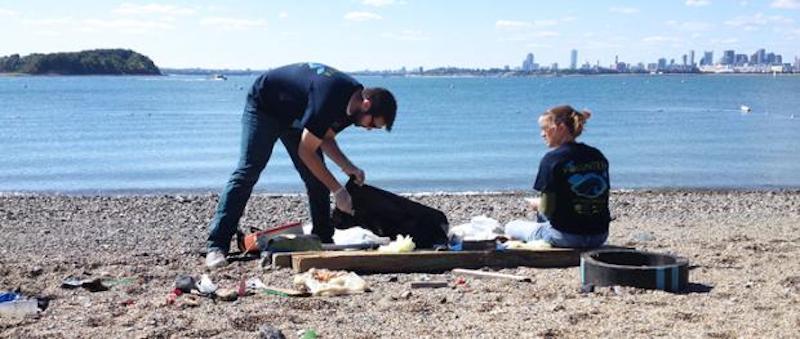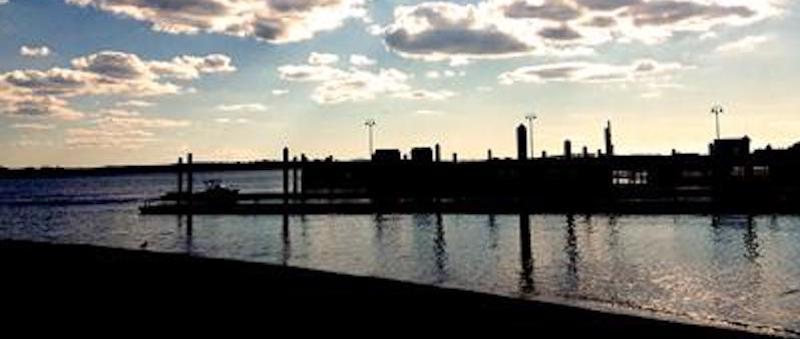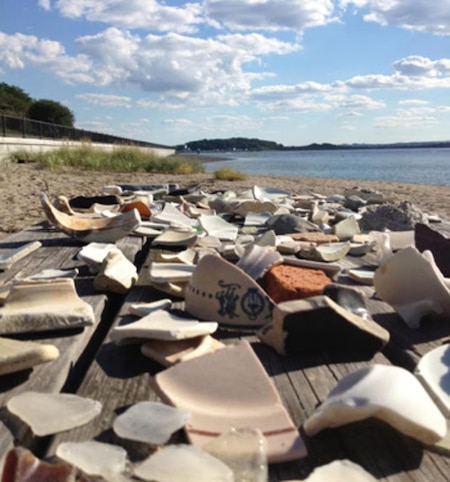This blog about COASTSWEEP—the annual beach cleanup organized by the Massachusetts Office of Coastal Zone Management (CZM)—gives a first-hand account of what a cleanup is like and why it matters.
The details...
Since 1987, thousands of volunteers have scoured the shores of Massachusetts through COASTSWEEP, the statewide beach cleanup organized by the Massachusetts Office of Coastal Zone Management (CZM). These dedicated volunteers collect and document “marine debris,” the technical term for trash and other discarded items that end up in the ocean and the coastal environment.
In June 2014, I began working as an intern with the COASTSWEEP program. For the first three full months, I read, wrote, spoke, explained, and even dreamed some variation of the above words. I also looked at data and statistics, read articles on marine debris, and dissected blog posts for interesting tidbits. Up to that point, I had essentially absorbed about all anyone could possibly want to know about marine debris and beach cleanups—other than what it was actually like to do one. But luckily this changed when I joined five coworkers for a mini-office cleanup at Boston Harbor’s Spectacle Island on September 17, 2014.
I personally had never been to Spectacle Island before, so I decided to read a little about the area before walking its shores. The island apparently originated as two drumlins connected by a thin stretch of land, giving it the appearance of glasses or spectacles (the alleged origin of the name). In the mid-1800s, a horse rendering plant and trash incinerator were built on the site, with the latter remaining in use until 1935. After the incinerator closed, trash was simply dumped on the island as it took on the role of landfill, which added more surface area and mass. The island remained a dump until the 1990s when dirt from the Big Dig was transported over to cover it. After much landscaping, resurfacing, building, and planting, a bigger and better Spectacle Island opened in 2006 for recreational use. The island, which is managed by the state’s Department of Conservation and Recreation (DCR), now consists of beaches, hiking trails, a visitor center, and docking for private boats. The hill-like mounds also offer amazing views of Boston Harbor and the city skyline (and no, I do not work for the tourism board).
So with this in mind, the six of us set out from the office toward the ferry at Long Wharf with our matching COASTSWEEP t-shirts. A better day could not have been chosen to do a cleanup—the blue, sunny skies and moderate temperature were perfect. We only had to wait a little bit for the ferry. It was mere moments more before I remembered that I get terribly, terribly seasick (luckily the ferry trip was short enough that no queasiness was felt). After 20 minutes, we arrived at Spectacle to the immediate warning that there were no trashcans on the island and all trash was carry-in/carry-out. Perhaps a foreshadowing of the amount of trash that had been discarded by unprepared visitors?
Rangers ask that people leave them there as they
are part of the island’s history.
Upon leaving the ferry, we met with one of the island’s rangers, who was very helpful in giving us some background on the island as well as showing us where we would be cleaning. As we crossed the threshold from pavement to sand, we immediately began to notice shards of sea glass, pieces of pottery, and old, rubber shoe heels. When we asked the ranger about these items, she told us that these pieces are left over from when the area was still a massive landfill. She also requested that these items remain, not only for their historical significance, but also so that future visitors could enjoy their presence as we did. I think the many shoe heels scattered about were one of the strangest things we found all day.
Once we were settled, it was time to start the cleanup. Our first mission was to spell out C-O-A-S-T-S-W-E-E-P in trash. As we set about looking for straws to make a “W” or plastic bags to shape an “S,” I noticed right away that there was not nearly as much trash as I assumed there would be. Whether it was due to the park rangers’ phenomenal efforts, respectful visitors, or our location, the beach was relatively clean. Despite this, however, it took us no time to find enough trash to spell out COASTSWEEP…and then some. As time went on and we made our way farther down the beach, there were a few things I began to notice. The most obvious for me was the overall lack of cigarette butts. Every article on marine debris I have read or data sheet I have seen has made it abundantly clear that cigarette butts are by far the most common item found at beach cleanups. For an item found 2,043,470 times during 2013’s International Coastal Cleanup and 39,056 times during our Massachusetts 2013 COASTSWEEP cleanups—our group collected a mere 20. And I did not find any. I truly was astounded at how few there were—and none of the long-time CZM COASTSWEEP participants have a theory on why Spectacle is so butt free.
After roughly two and a half hours, we had just about picked our stretch of beach clean. We also had recorded the type of marine debris we found. This was actually more difficult than I thought it would be. There were a lot of questions like, “Is this food wrapping or plastic packaging?” or “Does this count as a strapping band?” But since only the “most likely to find items” are tallied, not every strange item collected had to be recorded. For our cleanup, the top five items recorded were:
- Food Wrappers: 109
- Foam Pieces: 41
- Plastic Pieces: 38
- Plastic Bottle Caps: 35
- Straws/Stirrers: 21
Unsurprisingly, four out of the top five items found were plastic products due to its prevalence and floatability. What was surprising was how little of the data card’s “Most Likely to Find Items” were found. We found no plastic or foam take-out containers, metal bottle caps, or glass beverage bottles and only three utensils, two beverage cans, two grocery bags, and as mentioned before, 20 cigarette butts. In addition, other than the islands native shoe heels, the most interesting item found was what resembled a giant, black, wooden Cheerio. What purpose did that serve before washing up on these shores? We don’t know, but it certainly is odd. With the cleanup done, we collected about a full bag’s worth of combined trash and recyclables, as well as some larger debris items (including a large couch cushion!). After dropping off the trash, we headed toward the ferry with the feeling of a job well done on a great day at the beach.
Once the ferry reached the shore, I had to sprint to try and catch the next train home, so it wasn’t until I made the train and my heart rate slowed that I was able to reflect on my first COASTSWEEP cleanup. It was gratifying to see a cleanup in action, even if ours was on a small scale. It was also satisfying knowing that even though it was only one bag of trash, there is still that much less trash out in the environment because of our efforts. But the highlight of my day came about an hour later…
As the train pulled into my stop, I stood up to get in line to get off. While I was standing there waiting, a man tapped me on the shoulder. When I turned around, he asked me about my shirt, and I looked down and realized I was still wearing my COASTSWEEP t-shirt. I mentioned that I was interning with CZM and we had done an office cleanup that day. He began to tell me how much fun he and his kids have participating in cleanups every year on the Charles River, and how he is always amazed at how many people are willing to come out and help such a great cause. We talked a little longer and when the train stopped, I thanked him for speaking up and started to walk toward my car with a smile on my face. As great as the COASTSWEEP cleanups are for the environment and marine life, they also play an important role in bringing together family, friends, and community members to help a greater good. A great ending to a great day.
Author
Steven Pilis interned with the Massachusetts Office of Coastal Zone Management (CZM) for the summer of 2014 as the COASTSWEEP Social Media and Marketing Intern. In addition to doing educational outreach and working with volunteers and vendors to make CZM’s annual beach cleanup a success, he worked to do his personal best to reduce man-made waste from ending up in the ocean. For more on Steven’s personal efforts to reduce waste and marine debris, see A Day in the Life: Altering the Average Day to Reduce Ocean Litter. In 2014, Steven completed his undergraduate degree in sociology and environmental studies at Suffolk University and began the pursuit of his Masters in Public Administration at Northeastern University in the fall of 2014.

